Related Research Articles

The Antarctic is a polar region around Earth's South Pole, opposite the Arctic region around the North Pole.
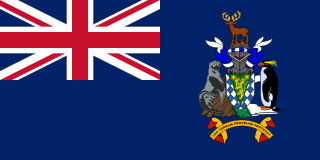
South Georgia and the South Sandwich Islands (SGSSI) is a British Overseas Territory in the southern Atlantic Ocean. It is a remote and inhospitable collection of islands, consisting of South Georgia and a chain of smaller islands known as the South Sandwich Islands. South Georgia is 165 kilometres (103 mi) long and 35 kilometres (22 mi) wide and is by far the largest island in the territory. The South Sandwich Islands lie about 700 kilometres (430 mi) southeast of South Georgia. The territory's total land area is 3,903 km2 (1,507 sq mi). The Falkland Islands are about 1,300 kilometres (810 mi) west from its nearest point.

In physical geography, tundra is a type of biome where tree growth is hindered by frigid temperatures and short growing seasons. The term is a Russian word adapted from Sámi languages. There are three regions and associated types of tundra: Arctic tundra, alpine tundra, and Antarctic tundra.

An invasive species is an introduced species to an environment that becomes overpopulated and harms its new environment. Invasive species adversely affect habitats and bioregions, causing ecological, environmental, and/or economic damage. The term can also be used for native species that become harmful to their native environment after human alterations to its food web. Since the 20th century, invasive species have become a serious economic, social, and environmental threat worldwide.

The Antarctic realm is one of eight terrestrial biogeographic realms. The ecosystem includes Antarctica and several island groups in the southern Atlantic and Indian oceans. The continent of Antarctica is so cold that it has supported only 2 vascular plants for millions of years, and its flora presently consists of around 250 lichens, 100 mosses, 25–30 liverworts, and around 700 terrestrial and aquatic algal species, which live on the areas of exposed rock and soil around the shore of the continent. Antarctica's two flowering plant species, the Antarctic hair grass and Antarctic pearlwort, are found on the northern and western parts of the Antarctic Peninsula. Antarctica is also home to a diversity of animal life, including penguins, seals, and whales.

The Antarctic fur seal is one of eight seals in the genus Arctocephalus, and one of nine fur seals in the subfamily Arctocephalinae. Despite what its name suggests, the Antarctic fur seal is mostly distributed in Subantarctic islands and its scientific name is thought to have come from the German vessel SMS Gazelle, which was the first to collect specimens of this species from Kerguelen Islands.
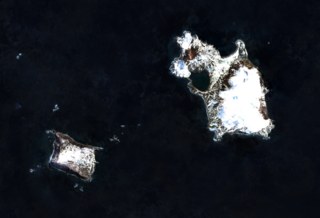
Vindication Island is a small uninhabited island of the Candlemas Islands in the South Sandwich Islands. It is one of about a dozen islands that make up the South Sandwich island arc, a chain of volcanoes in the Southern Ocean that was discovered in 1775 by James Cook. The volcanism is caused by the subduction of the South American Plate beneath the Sandwich Plate.

The Scotia Plate is a minor tectonic plate on the edge of the South Atlantic and Southern oceans. Thought to have formed during the early Eocene with the opening of the Drake Passage that separates Antarctica and South America, it is a minor plate whose movement is largely controlled by the two major plates that surround it: the Antarctic Plate and the South American Plate. The Scotia Plate takes its name from the steam yacht Scotia of the Scottish National Antarctic Expedition (1902–04), the expedition that made the first bathymetric study of the region.
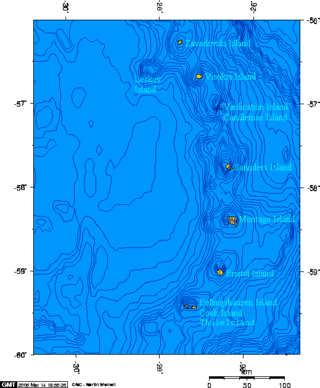
Protector Shoal is the shallowest point of the Protector Seamounts, a group of submarine volcanoes in the Southern Ocean. They are part of the South Sandwich island arc, a volcanic arc that has given rise to the South Sandwich Islands. Protector Shoal reaches a depth of 55 metres (180 ft) below sea level and is part of a larger group of seamounts that formed atop a larger ridge. Some of these seamounts bear traces of sector collapses, and one is capped by nested calderas.
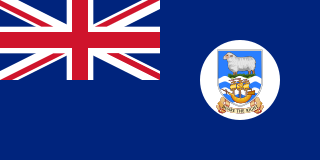
The Falkland Islands Dependencies was the constitutional arrangement from 1843 until 1985 for administering the various British territories in Sub-Antarctica and Antarctica which were governed from the Falkland Islands and its capital Stanley.

The South American–Antarctic Ridge or simply American-Antarctic Ridge is the tectonic spreading center between the South American Plate and the Antarctic Plate. It runs along the sea-floor from the Bouvet Triple Junction in the South Atlantic Ocean south-westward to a major transform fault boundary east of the South Sandwich Islands. Near the Bouvet Triple Junction the spreading half rate is 9 mm/a (0.35 in/year), which is slow, and the SAAR has the rough topography characteristic of slow-spreading ridges.

Antarctica is Earth's southernmost and least-populated continent. Situated almost entirely south of the Antarctic Circle and surrounded by the Southern Ocean, it contains the geographic South Pole. Antarctica is the fifth-largest continent, being about 40% larger than Europe, and has an area of 14,200,000 km2 (5,500,000 sq mi). Most of Antarctica is covered by the Antarctic ice sheet, with an average thickness of 1.9 km (1.2 mi).

The wildlife of Antarctica are extremophiles, having adapted to the dryness, low temperatures, and high exposure common in Antarctica. The extreme weather of the interior contrasts to the relatively mild conditions on the Antarctic Peninsula and the subantarctic islands, which have warmer temperatures and more liquid water. Much of the ocean around the mainland is covered by sea ice. The oceans themselves are a more stable environment for life, both in the water column and on the seabed.

The Northeast Georgia Rise is an oceanic plateau located in the South Atlantic Ocean northeast of South Georgia Island and west of the Falkland Plateau.

Terry Jean Wilson is an international leader in the study of present-day tectonics in Antarctica. She has led large, international efforts, such as Polar Earth Observing Network (POLENET), to investigate the interactions between the Earth's crust and the cryosphere in Antarctica.
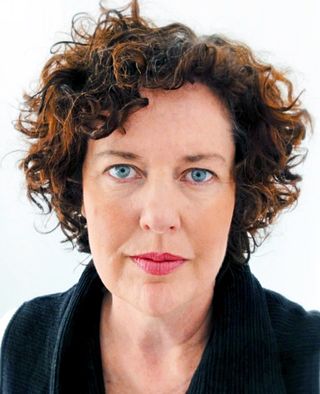
Dana Michelle Bergstrom is a senior researcher at the Australian Antarctic Division most notable for her work on identifying and mitigating risks against Antarctic and Sub Antarctic Ecosystems.

Roumiana Panayotova Metcheva is a Bulgarian Antarctic researcher, best known for her work on ecotoxicology and biodiversity protection in the Antarctic. She is the Head of Department of Ecosystem Research, Environmental Risk Assessment and Conservation Biology at the Bulgarian Academy of Sciences. Mount Mecheva was named after Metcheva for recognition of her work.

Justine Shaw is an Australian Antarctic researcher, best known for her conservation work on subantarctic islands, currently working at the Queensland University of Technology. She has a wide global research network, having worked in Australia, South Africa, sub-Antarctic/Antarctic and the Arctic.

Kim Crosbie is a former Executive Director of the International Association of Antarctica Tour Operators (IAATO) and has been working in the polar regions since 1991.
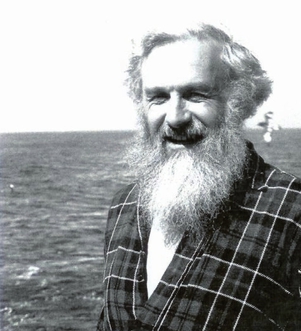
William Nigel Bonner was a British zoologist, Antarctic marine mammal specialist, author and ecologist. The topics of his books and scientific publications included marine animals, reindeer and the ecology of the Antarctic. He headed the Life Sciences Division of the British Antarctic Survey from 1974 to 1986, and served as deputy director from 1986 to 1988. Bonner received the Polar Medal in 1987, in recognition of his work in Antarctica.
References
- 1 2 "Antarctica no place for old socks - or alien seed". Business Day Live. Retrieved 2016-06-19.
- 1 2 "Personnel". www.gov.gs. Government of South Georgia & the South Sandwich Islands. Retrieved 2016-06-19.
- 1 2 3 4 Blockley, David. "Dr Jennifer Lee". www.south-atlantic-research.org. Archived from the original on 2016-08-09. Retrieved 2016-06-19.
- 1 2 "Preventing a marine invasion in the subantarctic". www.antarctica.gov.au. 18 November 2011. Retrieved 2016-06-19.
- ↑ Pyper, Wendy (1974). "Preventing a marine invasion in the sub-Antarctic". ECOS. 2011 (164). doi:10.1071/EC11072.
- 1 2 "CIB DST-NRF Centre of Excellence for Invasion Biology". academic.sun.ac.za. Retrieved 2016-06-19.
- 1 2 "Personnel | Government of South Georgia & the South Sandwich Islands". www.gov.gs. Retrieved 2016-06-19.
- ↑ Edgar, James (2014-02-19). "Thousands of reindeer culled in UK territory". Telegraph.co.uk. Retrieved 2016-06-19.
- ↑ Lee, J. E.; Chown, S. L. (2009-07-02). "Temporal development of hull-fouling assemblages associated with an Antarctic supply vessel". Marine Ecology Progress Series. 386: 97–105. Bibcode:2009MEPS..386...97L. doi: 10.3354/meps08074 . hdl: 10019.1/119914 .
- ↑ Lee, Jennifer E.; Chown, Steven L. (2009-10-01). "Breaching the dispersal barrier to invasion: quantification and management". Ecological Applications. 19 (7): 1944–1959. Bibcode:2009EcoAp..19.1944L. doi: 10.1890/08-2157.1 . hdl: 10019.1/119891 . ISSN 1939-5582. PMID 19831082.
- ↑ Lee, Jennifer E.; Chown, Steven L. (2009-10-01). "Quantifying the propagule load associated with the construction of an Antarctic research station". Antarctic Science. 21 (5): 471–475. Bibcode:2009AntSc..21..471L. doi:10.1017/S0954102009990162. hdl: 10019.1/120026 . ISSN 1365-2079. S2CID 129932725.
- ↑ Chown, Steven L.; Huiskes, Ad H. L.; Gremmen, Niek J. M.; Lee, Jennifer E.; Terauds, Aleks; Crosbie, Kim; Frenot, Yves; Hughes, Kevin A.; Imura, Satoshi (2012-03-27). "Continent-wide risk assessment for the establishment of nonindigenous species in Antarctica". Proceedings of the National Academy of Sciences. 109 (13): 4938–4943. Bibcode:2012PNAS..109.4938C. doi: 10.1073/pnas.1119787109 . ISSN 0027-8424. PMC 3323995 . PMID 22393003.
- ↑ Huiskes, Ad H. L.; Gremmen, Niek J. M.; Bergstrom, Dana M.; Frenot, Yves; Hughes, Kevin A.; Imura, Satoshi; Kiefer, Kate; Lebouvier, Marc; Lee, Jennifer E. (2014-03-01). "Aliens in Antarctica: Assessing transfer of plant propagules by human visitors to reduce invasion risk". Biological Conservation. 171: 278–284. Bibcode:2014BCons.171..278H. doi: 10.1016/j.biocon.2014.01.038 .